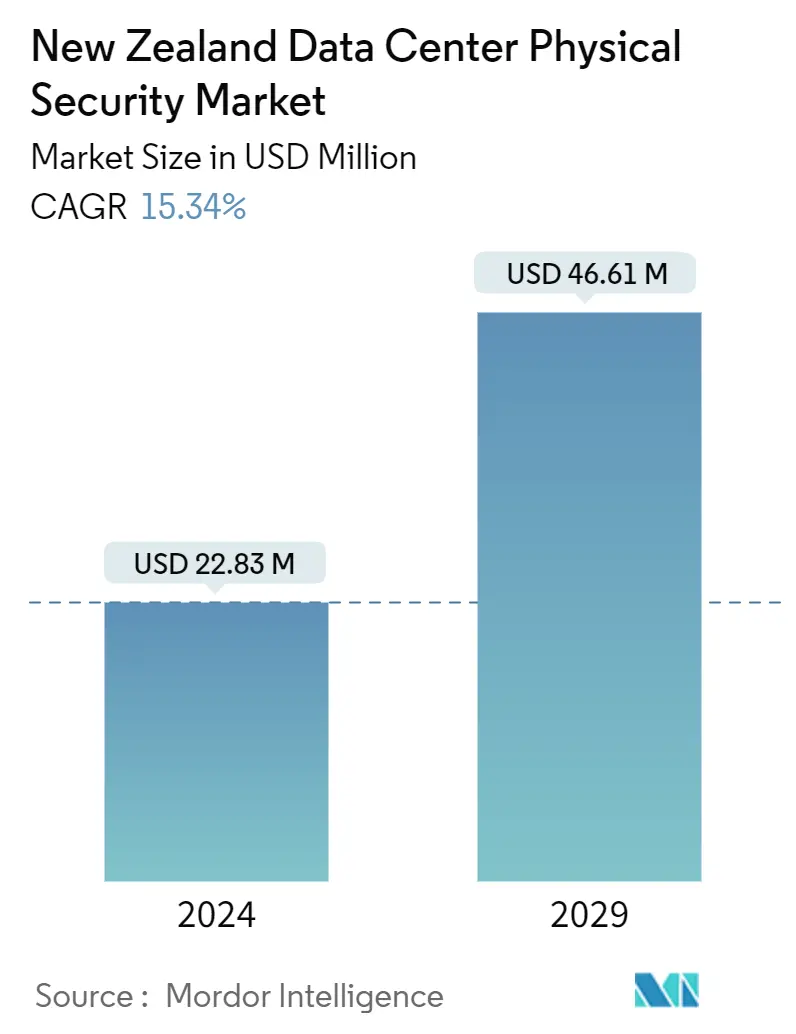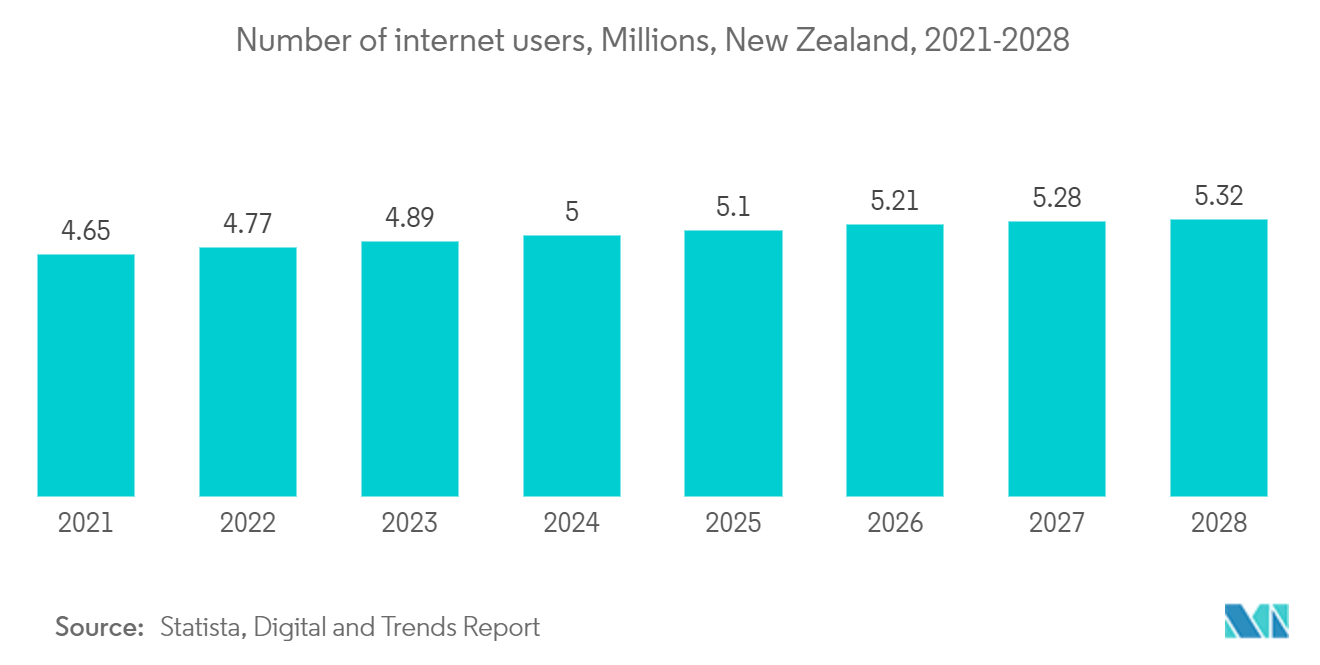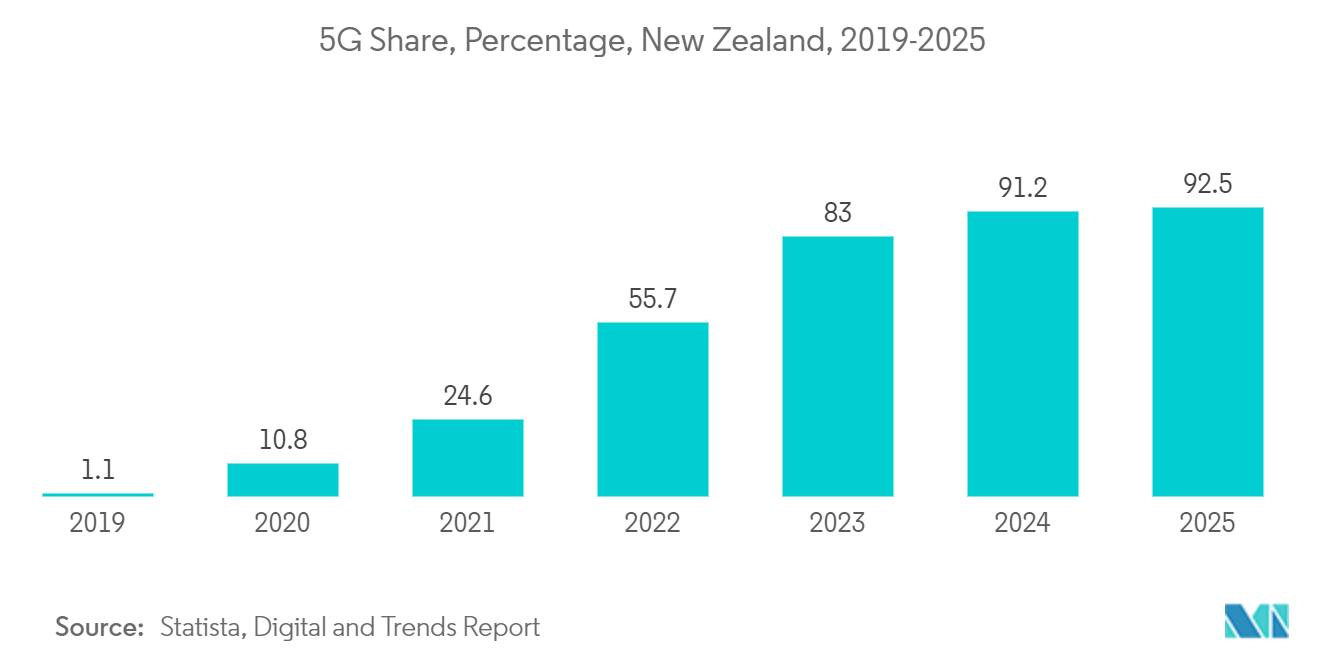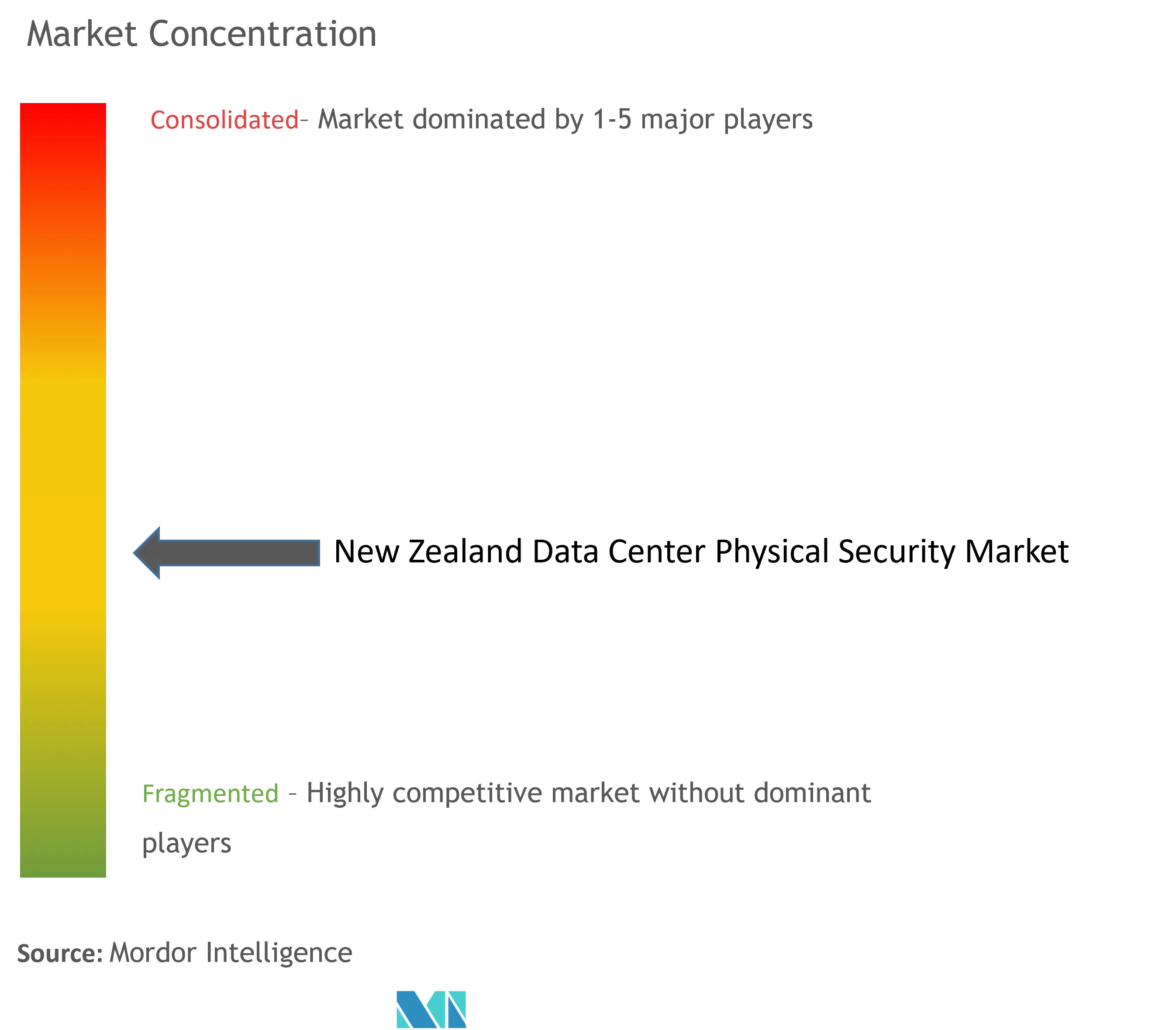New Zealand Data Center Physical Security Market Size

| Study Period | 2018 - 2029 |
| Base Year For Estimation | 2023 |
| Market Size (2024) | USD 22.83 Million |
| Market Size (2029) | USD 46.61 Million |
| CAGR (2024 - 2029) | 15.34 % |
| Market Concentration | Medium |
Major Players
*Disclaimer: Major Players sorted in no particular order |
New Zealand Data Center Physical Security Market Analysis
The New Zealand Data Center Physical Security Market size is estimated at USD 22.83 million in 2024, and is expected to reach USD 46.61 million by 2029, growing at a CAGR of 15.34% during the forecast period (2024-2029).
The security measures can be categorized into computer room controls, facility controls, perimeter security, and cabinet controls. The first layer of data center security is detecting, delaying, and discouraging unauthorized personnel entry at the perimeter. Upon breach of the perimeter monitoring, the second layer of defense withholds access. It is an access control system which uses card swipes or biometrics. The third layer further restricts access through diverse verification methods by monitoring all restricted areas and deploying entry restrictions such as turnstile with VCA, biometric access control devices for thumbprints, irises, or vascular patterns, and using radio frequency identification. The initial three layers ensure only authorized entry. However, additional security to restrict access comprises cabinet locking mechanisms. It addresses the fear of an 'insider threat,' such as a malicious employee.
- Under Construction IT Load Capacity: The upcoming IT load capacity of the New Zealand data center market is expected to reach 350 MW by 2029.
- Under Construction Raised Floor Space: The country's construction of raised floor area is expected to increase to 800K sq. ft by 2029.
- Planned Racks: The country's total number of racks to be installed is expected to reach 35K units by 2029. Auckland is expected to house the maximum number of racks by 2029.
- Planned Submarine Cables: There are close to 8 submarine cable systems connecting New Zealand, and many are under construction. One such submarine cable estimated to start service in 2025 is Hawaiki Nui, which stretches over 25,000 kilometers with landing points from Christchurch, Dunedin, and Invercargill.
New Zealand Data Center Physical Security Market Trends
Video Surveillance Segment Holds Significant Share
- Since sensitive and important data is stored in data centers, security is a top priority. Data center operators use video surveillance systems to ensure security standards and regulations are met. This allows operators to monitor access, detect unauthorized access, and maintain compliance.
- Video surveillance serves as a cost-effective solution to prevent physical attacks and unauthorized access to critical data, reducing the risk of data breaches and leaks. Cameras are installed at entrances and exits, allowing security personnel to easily identify and track the source of unauthorized access or damage to servers.
- Smartphone connectivity in the country has been steadily and slightly increasing over the years. The number of smartphone users is expected to increase from 6.48 million in 2022 to 7.1 million in 2029. Between January 2020 and January 2021, the number of mobile connections in New Zealand increased by 78,000 (+1.2%). In January 2021, the number of mobile connections in New Zealand was equivalent to 135.6% of the total population. The majority of New Zealanders own a smartphone. In 2022, smartphone penetration in the country was expected to be around 92%. In 2021, post-paid mobile phone connections accounted for the country's vast majority of mobile subscriptions. This signifies the increase in data traffic, which drives the increase in data centers and the demand for video surveillance that can help prevent malicious or erroneous operations. Video surveillance also provides evidence to identify responsible parties when an incident occurs.
- New Zealand witnessed increased speeds of 4G and 5G over the years, peaking at 66 Mbps and 431 Mbps by 2029, respectively. The country officially launched 5G in 2019 and witnessed an average speed of 159.47 Mbps. New Zealanders require large amounts of data for everyday living, from communicating via social media platforms to purchasing goods online and for entertainment. The growth of the telecom industry is driving the increase in data centers, increasing the need for video surveillance that also acts as a powerful deterrent, reducing the chances of physical attacks and unauthorized access to critical data.

IT & Telecommunication Segment Holds Major Share
- ICT is key to the New Zealand government's strategy to foster innovation and local production. Collaboration between banks, the ICT industry, and the New Zealand government has created an atmosphere of community and information sharing. Notably, New Zealand startups saw a significant increase in deals and investment, with a 63% increase in total spend from 2020 to 2021.
- New Zealand is easing border restrictions on ICT professionals in a bid to attract the largest digital talent pool from around the world to the island nation. At the forefront of these border exclusions is NZTech, a government-funded marketing organization set up to promote New Zealand technology to global markets. As the company's CEO acknowledged, as New Zealand's digital economy grows, the country needs more tech workers. In addition, the country is likely to see even greater demand for skilled workers in the technology industry.
- The market witnessed increasing investments from large corporations. Microsoft, the hyperscale operator, announced the opening of cloud regions in 2022. AWS announced the AWS Asia-Pacific (Auckland) Cloud Region, which is expected to go live in 2024.
- Telecommunications methods have changed over the years, and New Zealanders need reliable telecommunications services for many aspects of their daily lives. The proportion of active internet users has increased overall, which is in line with global trends, supporting the country's ongoing digital transition. The Ultra-Fast Broadband Initiative was a New Zealand government program to build a fiber optic network to cover 87% of the population by the end of 2022. It is a public-private partnership between the government and four companies, with a total government investment of NZD 1.7 billion (USD 10.19 billion).
- Fixed broadband subscribers are expected to increase due to an increase in households and a decrease in the number of underserved facilities that were previously unconnected. This drives the adoption of data centers in the telecom industry in the country.

New Zealand Data Center Physical Security Industry Overview
The market is highly fragmented due to the presence of key players like Axis Communications AB, ABB Ltd, and Bosch Sicherheitssysteme GmbH, among others, which play a vital role in upscaling the capabilities of enterprises. Market orientation leads to a highly competitive environment. The biggest retail and wholesale data center market companies have been further trying to make their system secure and safe from thefts. There has been a wave of consolidation in the secondary markets as smaller players seek to scale to compete and big players scale their products in the market.
For instance, in October 2023, Zwipe partnered with Schneider Electric’s Security Solutions Group. Schneider Electric plans to introduce the Zwipe Access fingerprint-scanning smart card to its clientele. This card will be integrated with Schneider Electric’s Continuum and Security Expert platforms, serving a client base from sectors including airports, transportation, healthcare, data centers, and more.
New Zealand Data Center Physical Security Market Leaders
-
Axis Communications AB
-
ABB Ltd
-
Bosch Sicherheitssysteme GmbH
-
Johnson Controls.
-
Schneider Electric
*Disclaimer: Major Players sorted in no particular order

New Zealand Data Center Physical Security Market News
- February 2024: In the latest release of the Axis operating system, AXIS OS, Axis Communications AB announced that more than 200 network devices, including cameras, intercoms, and 11.8 audio speakers are supported by the IEEE MAC 802.1sec security standard. Demonstrating the company's continued commitment to device and data security, Axis has become the first manufacturer of physical safety products supporting MACsec Media Access Control Security.
- April 2023: Schneider Electric launched EcoCare for Modular Data Centers services membership. Members of this innovative service plan benefit from specialized expertise to maximize modular data centers' uptime with 24/7 proactive remote monitoring and condition-based maintenance. Members draw benefit from support provided in the form of a dedicated customer success management team, who become their coach, planning on-site and remote services team, monitoring maintenance and infrastructure needs at a system level, rather than an ad-hoc approach for each asset only when problems arise.
New Zealand Data Center Physical Security Market Report - Table of Contents
1. INTRODUCTION
1.1 Study Assumption and Market Definition
1.2 Scope of the Study
2. Research Methodology
3. Executive Summary
4. Market Dynamics
4.1 Market Overview
4.2 Market Drivers
4.2.1 Increasing Data Traffic and Need for Secured Connectivity Promoting Growth
4.2.2 Rise in Cyber Threats is Driving the Growth of the Market
4.3 Market Restraints
4.3.1 Limited IT Budgets, Availability of Low-Cost Substitutes, and Piracy
4.4 Value Chain/Supply Chain Analysis
4.5 Industry Attractiveness - Porter's Five Forces Analysis
4.5.1 Threat of New Entrants
4.5.2 Bargaining Power of Buyers/Consumers
4.5.3 Bargaining Power of Suppliers
4.5.4 Threat of Substitute Products
4.5.5 Intensity of Competitive Rivalry
4.6 Assessment of COVID-19 Impact
5. MARKET SEGMENTATION
5.1 By Solution Type
5.1.1 Video Surveillance
5.1.2 Access Control Solutions
5.1.3 Other Solution Types (Mantraps and Fences and Monitoring Solutions)
5.2 By Service Type
5.2.1 Consulting Services
5.2.2 Professional Services
5.2.3 Other Service Types (System Integration Services)
5.3 By End User
5.3.1 IT & Telecommunication
5.3.2 BFSI
5.3.3 Government
5.3.4 Healthcare
5.3.5 Other End Users
6. COMPETITIVE LANDSCAPE
6.1 Company Profiles
6.1.1 Axis Communications AB
6.1.2 ABB Ltd
6.1.3 Bosch Sicherheitssysteme GmbH
6.1.4 Honeywell International Inc.
6.1.5 Johnson Controls.
6.1.6 Schneider Electric
6.1.7 ASSA ABLOY
6.1.8 Cisco Systems Inc.
6.1.9 Dahua Technology
6.1.10 Hangzhou Hikvision Digital Technology Co. Ltd (Hikvision)
7. INVESTMENT ANALYSIS
8. MARKET OPPORTUNITIES AND FUTURE TRENDS
New Zealand Data Center Physical Security Industry Segmentation
The data center physical security market refers to the industry focused on providing products and services to safeguard the physical infrastructure and assets of data centers. This includes measures to protect data centers from unauthorized access to premises, hardware theft, vandalism, sabotage, terrorist acts, and other physical threats. Key components of data center physical security may include video surveillance and monitoring, access control systems, physical barriers, biometric authentication, and environmental controls designed to ensure the safety and integrity of the data center environment.
The New Zealand data center physical security market is segmented by solution type, service type, and end-user industry. By type, the market is segmented into video surveillance and access control solutions. By service type, the market is segmented into consulting services and professional services. By end-user industry, the market is segmented into IT & telecommunication, BFSI, government, media & entertainment, and other end-users. The market sizes and forecasts are provided in terms of value (USD) for all the above segments.
New Zealand Data Center Physical Security Market Research FAQs
How big is the New Zealand Data Center Physical Security Market?
The New Zealand Data Center Physical Security Market size is expected to reach USD 22.83 million in 2024 and grow at a CAGR of 15.34% to reach USD 46.61 million by 2029.
What is the current New Zealand Data Center Physical Security Market size?
In 2024, the New Zealand Data Center Physical Security Market size is expected to reach USD 22.83 million.
Who are the key players in New Zealand Data Center Physical Security Market?
Axis Communications AB, ABB Ltd, Bosch Sicherheitssysteme GmbH, Johnson Controls. and Schneider Electric are the major companies operating in the New Zealand Data Center Physical Security Market.
What years does this New Zealand Data Center Physical Security Market cover, and what was the market size in 2023?
In 2023, the New Zealand Data Center Physical Security Market size was estimated at USD 19.33 million. The report covers the New Zealand Data Center Physical Security Market historical market size for years: 2018, 2019, 2020, 2021, 2022 and 2023. The report also forecasts the New Zealand Data Center Physical Security Market size for years: 2024, 2025, 2026, 2027, 2028 and 2029.
New Zealand Data Center Physical Security Industry Report
Statistics for the 2024 New Zealand Data Center Physical Security market share, size and revenue growth rate, created by Mordor Intelligence™ Industry Reports. New Zealand Data Center Physical Security analysis includes a market forecast outlook for 2024 to 2029 and historical overview. Get a sample of this industry analysis as a free report PDF download.



